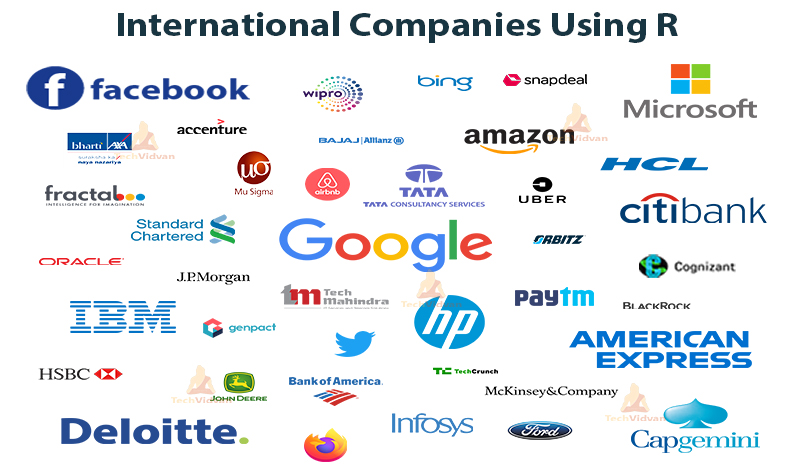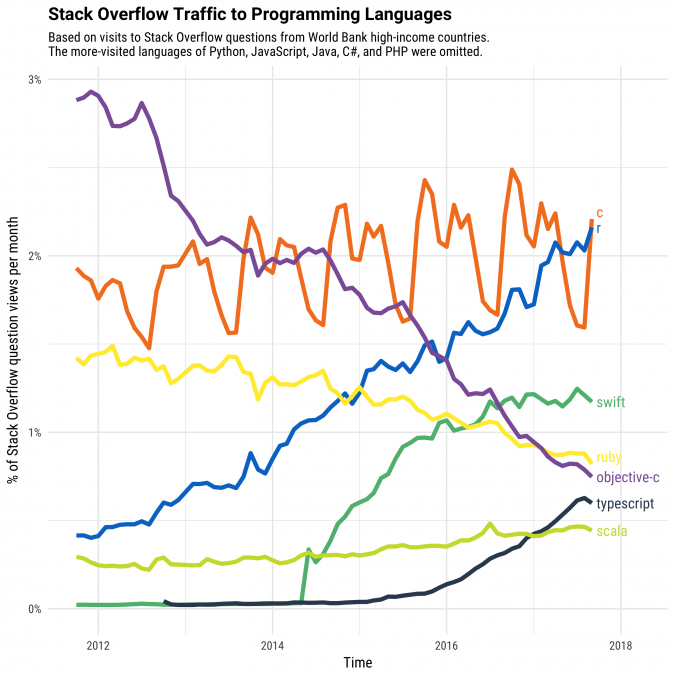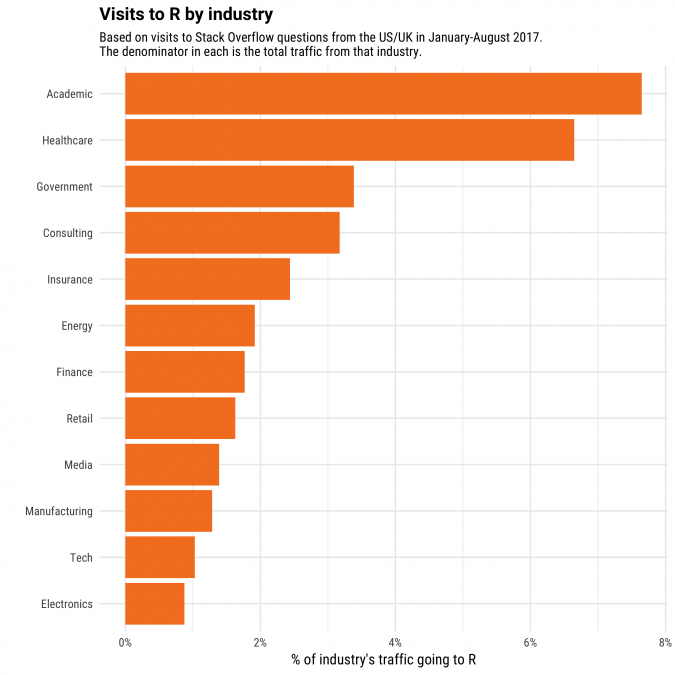Career in R Programming and its Scope by 2025
In this article, you will get the current status of R in corporates. From this, a beginner can obtain future insights for a career in R programming.
Learning a dead technology is not a wise career choice. The same goes for a technology that is going to die out or become obsolete shortly.
How good of a career choice learning R would be?
What kind of jobs are out there for R programmers?
Who hires R programmers?
How a career in R programming helps to become a data scientist?
In this post, you will get insight into these types of questions and more.
And no, I am not talking about where R will stand out in competition five years from now… I’m talking about how you can survive in the competition.
Before R, large companies used expensive statistical analysis tools like SPSS or SAS. When it came to the market as an open-source language, it was a game-changer in the data science industry. It hasn’t stopped making waves yet. R community still represents the cutting-edge in the field of data science.
Growth of Data Science
The field of data science has exploded in the past two decades and shows no signs of stopping any time soon. Many big or small businesses and companies wish to make use of the insights gained through the big data.
Every day billions of people around the world are generating new data. Data scientists are required to sift through this massive amount of data and make use of it.
Due to its open-source nature and its extreme versatility, R has become the primary tool for statistical analysis and data science. With the industry facing a shortage of data scientists all over the world, both novice and professional R programmers can enter.
Let’s look at the career in R programming in terms of job profiles, industry sectors and companies using R technology.
Career in R Programming
Here are a few reasons why it is still effective and why it is likely to stay this way in the future.
Job Profiles in R
There are around 1 million job openings for R programmers world. Job portals like LinkedIn, Glassdoor, Indeed, Monster, etc. all have thousands of job listings for data scientists and R programmers.
R programmers can find jobs in various companies and firms in roles such as:
Data Scientist: A data scientist’s job entails collecting data, transforming it into the desired format, analyzing it and then drawing insights from it. They analyze customer behavior and identify revenue opportunities.
They also develop statistical models for data analysis. You need experience of 1-5yrs for a job as a data scientist. The average yearly income of data scientists in the United States is around $375,000
Data Analyst: A data analyst works with IT and management teams to determine an organization’s business goal. They gather data, clean it, and analyze it to pinpoint trends and patterns.
On average, the experience required for a job as a data analyst is 1-3yrs. The annual income of an entry-level data analyst in the United States is $95,000
Business Analyst: A business analyst has to come up with technical solutions for business problems. They identify business needs and develop strategies to meet them. They evaluate data from various sources and communicate complex data in easy-to-understand ways.
To become a business analyst, you need 3+ yrs of experience in data science and strong business-knowledge. The average annual income of an entry-level business analyst in the United States is $97,000
Business Intelligence Expert: A business intelligence expert extracts data, analyzes it, visualize it and then helps with the business strategy and business decision-making process.
Experience of 2-4 yrs in data science, as well as knowledge of business strategy, is required for a job as a business intelligence expert. In the United States, the average yearly income of a business intelligence expert in $65,000
Data Visualization Expert: A data visualization expert helps to convert the results of the analysis into easy-to-read reports with graphs and charts instead of raw data. They take data and turn it into insights. You need strong visualization skills and knowledge of designing.
It takes the experience of 1-5 yrs to reach a good level at this job. The average yearly income of an entry-level data visualization expert in the United States is $112,000
Quantitative Analyst: A quantitative analyst is someone who has a good knowledge of finance apart from the technical skills to be a data scientist. They develop and implement complex mathematical models to help organizations make decisions about risk management, investments, and pricing.
You need a minimum 2-4yrs of experience in data science and strong knowledge of business and finance for a job as a quantitative analyst. The average yearly income of a quantitative analyst in the United States is $80,572
These are just some of the roles R programmers can fill in the industry. R’s versatility makes it useful for a wide variety of tasks and, thus, makes an R programmer a highly useful professional.
But will R be Relevant in the Future?
R technology is more than two decades old. Yet experts believe, it will be important in the future. The truth of the matter is that today R is an ideal programming tool for analysis in Data Science.
In this world, where new technologies and breakthroughs come every day, how has R stayed relevant for so long?
R’s Usefulness in Businesses
R is a beast when it comes to data processing but it doesn’t stop there. R can also visualize the results to create elegant, eye-catching and easy-to-understand reports with graphs and charts of crisp and high quality. R is most famous for its visualization library ggplot2.
This makes R an indispensable tool for business intelligence and business decision-making process.
R can also create web apps that allow users to interact with the data and result of the analysis. This helps in communicating the results to a larger audience.
Industry Sectors Using R
Source: StackOverflow
R’s wide use range means that it is used in one way or another in almost every major industry sector:
Academics: R is primarily a research tool. Many prominent universities and institutes use it to gain insights from large data samples.
Healthcare: R is used in pharmaceutical research and also to analyze genetic sequences to identify disorders and to isolate genes responsible for various factors.
Government: Many government agencies use R for record-keeping as well as to process the accumulated data.
IT: Many major IT companies use R to gain insights from big data to support their business strategies. They also use it to provide business intelligence for their clients and for machine learning and deep learning projects and researches.
Finance & Banking: Financing and Banking firms use R for fraud detection, investment risk assessment, business strategy, and to predict market trends.
Social Media: Social media companies use R to analyze their user behavior, to suggest better advertisements, to improve their search results and for sentiment analysis.
E-commerce: E-commerce companies use R to identify potential customers, for targeted advertising, and to analyze customer feedback.
Search Engines: Search engines use R to improve their search results, for behavior analysis and to improve search and page suggestions.
Public Welfare: The Food and Drug Administration (FDA) uses R for drug research and for testing food products. The US National Weather Service uses R to analyze weather patterns and to predict storms and disasters.
Companies Using R
As we saw earlier, R is used in almost every sector and by a lot of companies. Some of the large companies that use R:

There are many more companies, be they small or large, that use R for various purposes.
Summary
Data science in general and R specifically are doing great in the industry and it seems like they will be doing the same for the foreseeable future.
The R programming language’s vast community ensures that R does not get outdated or old-school as they keep adding new functionalities and updates.
In this article, we learned about the future scope of the R language and data science, the roles R programmers fill in companies and what these jobs entail.
In all, a career in R programming can just skyrocket your journey in Data Science.
Read a brief introduction to R and get familiar with its environment.
And TechVidvan welcome your comments if you have any doubts about R.
Good luck with R programming.


